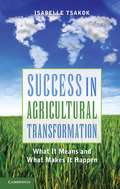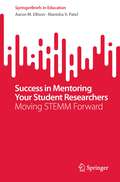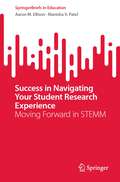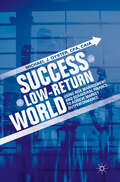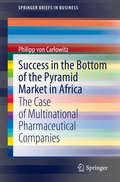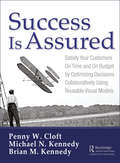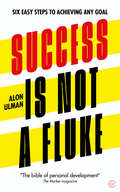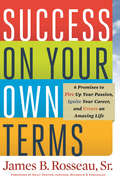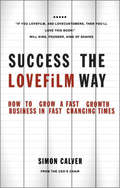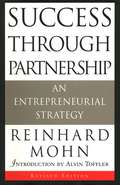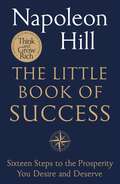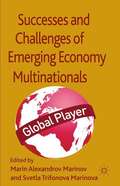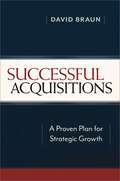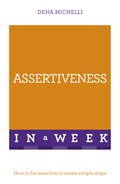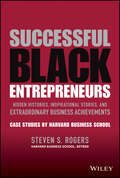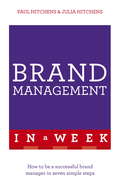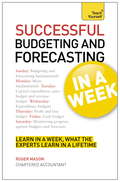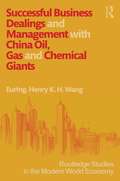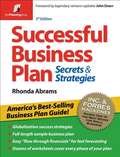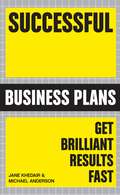- Table View
- List View
Success in Agricultural Transformation
by Isabelle TsakokTo lift and keep millions out of poverty requires that smallholder agriculture be productive and profitable in the developing world. Do we know how to make this happen? Researchers and practitioners still debate how best to do so. The prevailing methodology, which claims causality from measures of statistical significance, is inductive and yields contradictory results. In this book, instead of correlations, Isabelle Tsakok looks for patterns common to cases of successful agricultural transformation and then tests them against other cases. She proposes a hypothesis that five sets of conditions are necessary to achieve success. She concludes that government investment in and delivery of public goods and services sustained over decades is essential to maintaining these conditions and thus successfully transform poverty-ridden agricultures. No amount of foreign aid can substitute for such sustained government commitment. The single most important threat to such government commitment is subservience to the rich and powerful minority.
Success in Evaluation: Focusing on the Positives (Comparative Policy Evaluation Ser.)
by Rudi TurksemaSuccess in Evaluation takes a fundamentally different approach to the mainstream supply side discussion of evaluation quality, utilization, and learning. The contributors believe that a systematic focus on success will lead to increased awareness of evaluation and its findings, a more positive attitude, and a greater chance of actual evaluation use. This book offers many different lessons on how to improve evaluation design, research processes, and reporting. It is a realistic look at performance management, the evidence movement, and the demand barriers that so often block the role evaluators can play in organizational learning and decision-making. International case studies and lessons are included that both explain success-oriented methods and share insightful lessons from the real world. Together, they present a convincing case that evaluation for success allows for increased constructive interaction amongst both stakeholders and evaluators and, as a result, learning processes and outcomes will improve.
Success in Math: Consumer Math (Success in Math Series)
by Globe FearonThis book helps students with varying learning styles master basic math concepts and prepares them for success on math competency tests. Student Texts This five-book softcover series breaks down core math concepts into short, manageable lessons that assume little background knowledge and are introduced in real-life contexts. In addition, chapter opener vocabulary lists and a glossary prove valuable for English language learners with below- or at-level math skills. Teacher's resources include answer Keys, as well as error analysis notes, alternative strategies for varied learning styles, problem-solving strategies, ESL notes, cooperative learning strategies, and reproducible masters are provided. - Helps students with varying learning styles master the basic math concepts they need to meet rigorous high school math and testing requirements. - Introduces students to the working world by presenting real-world examples and problems. - Supports independent learning with instruction, exercises, and partial Answer Keys.
Success in Mentoring Your Student Researchers: Moving STEMM Forward (SpringerBriefs in Education)
by Aaron M. Ellison Manisha V. PatelThis book is a guide for mentors on how to recruit, mentor, and support students through a student research experience in science, technology, engineering, mathematics, and medicine (STEMM) fields. Being a successful research mentor benefits from the self-awareness and planning, strategies and skills that Success in Mentoring your Student Researchers can help you build and develop. These are useful for mentors working with any students, but especially those who have been minoritized in STEMM or are the first in their family to attend college. The first part of the book introduces mentoring undergraduates and how it differs from traditional classroom instruction, active learning, and flipped classrooms; mentoring is collaboratively teaching research while doing research. A mentored undergraduate research experience also helps your mentees develop the skills necessary to be successful scientists and become part of STEMM communities. The central part of the book presents the undergraduate research experience as a “three-legged stool” whose legs—research, education, and community—each have unique values in advancing your mentees’ path in STEMM and all of which require setting, communicating, and realizing expectations for “success”--your mentees’ and your own. The last part of the book looks beyond the research experience, from evaluating your success as a mentor through helping your mentees to continue to develop and grow their STEMM careers and become mentors themselves. This book is the mentor’s companion to the authors’ book for students, “Success in Navigating your Student Research Experience: Moving Forward in STEMM.”
Success in Navigating Your Student Research Experience: Moving Forward in STEMM (SpringerBriefs in Education)
by Aaron M. Ellison Manisha V. PatelThis book is a complete guide for students on how to make the most of intensive, experiential research outside a college classroom. Engaging in research as an undergraduate can lead to successful and rewarding careers in science, technology, engineering, mathematics, and medicine (STEMM). Being successful in an undergraduate research experience benefits from the self-awareness and planning, strategies and skills that Success in Navigating your Student Research Experience can help you build and develop. The first part of this book describes strategies and processes for finding, applying, and preparing for an undergraduate research experience that matches your own needs and interests. These strategies are useful for any student, but are particularly helpful for individuals who have been minoritized in STEMM or are the first in their family to attend college. The central part of the book presents the undergraduate research experience as a “three-legged stool” whose legs—research, education, and community—each have unique values in advancing your path in STEMM. The last part of the book illustrates the many options for continuing and expanding your path in research. These range from communicating results to colleagues to moving forward with graduate studies and careers in STEMM, in which you can become a mentor to the next generation of students.This book is the student’s companion to the authors’ book for mentors, “Success in Mentoring your Student Researchers: Moving STEMM Forward.”
Success in a Low-Return World: Using Risk Management and Behavioral Finance to Achieve Market Outperformance
by Michael J. OysterFollowing the Great Financial Crisis, the S&P 500 advanced more than 17 percent annualized from February 2009 through June 2018. At this pace, a buy-and-hold investor in the stock market would see their money double in 5 years and more than triple in 7 years. This performance has lulled many investors into thinking that such above-average returns will be with us into perpetuity. Unfortunately, this may not be the case. Far more likely, the return an investor may receive from the stock market will be slightly better than half the long-term average, about 5% to 7%. Most investment portfolios hold a greater allocation to stocks than any other class of investment asset. Massive amounts of wealth were created from the bull market since early 2009 providing institutions and individuals with a rising tide that lifted their portfolios above their goals without much effort. The environment of the future stands to be far less accommodating, so finding suitable investments (other than U.S. stocks) that can achieve the necessary returns (or make up the shortfall) will be a critical component of achieving goals in years to come. This book will explore those solutions.
Success in the Bottom of the Pyramid Market in Africa: The Case of Multinational Pharmaceutical Companies (SpringerBriefs in Business)
by Philipp von CarlowitzThis book presents an empirical investigation of the efforts that multinational pharmaceutical companies take in order to find a business model that allows for a profitable access to the Bottom of the Pyramid (BoP) markets. The Bottom of the Pyramid in Africa is frequently mentioned as an attractive market due to its sheer size. Yet most companies struggle to access it because of the low price level, difficult physical market access and challenges when it comes to payment. More specifically, the book investigates the following business model-related questions: Do pharmaceutical companies provide products that meet the needs of the BoP? What characterizes the value generation of the company? What revenue model leads to a profitable business, and what role does a network of partners play in the business model? Findings reveal that there is no ‘one-size-fits-all’ answer to these questions. Providing continuous availability, affordability at a good quality of goods and services, creating health awareness, as well as localizing business to achieve a level of inclusiveness are essential prerequisites for success. In the last chapter this book provides a business model prototype that accounts for these key success factors for business at the Bottom of the Pyramid and points to further research topics.
Success is Assured: Satisfy Your Customers On Time and On Budget by Optimizing Decisions Collaboratively Using Reusable Visual Models
by Penny W. Cloft Michael N. Kennedy Brian M. Kennedy"Success is Assured" was born from a pair using those design practices over a century ago: The Wright Brothers. They set about methodically learning the causal relationships between the different design decisions they needed to make and the performance of the airplane. The Wright Brothers fundamentally transformed the front end of development into a sharply focused learning and decision-making process, and thereby eliminated the late - process rework in which their competition was stuck. Similarly, Toyota built an amazing manual product development system that consistently created a cadence of high quality products that customers want. Myriads of Lean principles, jargon, and tools have been introduced and applied with minimal impact on design loopbacks, engineering productivity, and knowledge reuse within small to midsize engineering companies – and almost no penetration within highly complex engineering companies. This book teaches methodologies to relentlessly expose knowledge gaps and trade-offs early and optimize results before detailed design begins, thereby avoiding the expensive firefighting and engineering rework that consume most of our engineering capacity today. This book teaches new thinking and methodologies to convert the chaotic front end of product development into a convergent process of set-based learning and continuous innovation – a game changer for companies that depend upon a steady flow of innovative products. Watch this video and understand how to consistently satisfy your customers on-time and on-budget! Visit www.SuccessIsAssured.com
Success is Not a Fluke: Six Easy Steps To Achieving Any Goal
by Alon UlmanSuccess is not a fluke. It has clear rules that can be learned. Alon Ulman, Ironman, bestselling author and renowned practical success speaker, shares how to gain immediate control of your life, and make any dream a reality."An amazing life is a matter of choice."Success in any endeavour can be achieved in just six essential steps. With these six steps, anyone can consciously elevate their life beyond their wildest expectations.Alon Ulman knows how unexpected life can be. In a plane above the Mediterranean Sea, Alon suddenly found he couldn't breathe. After landing he was rushed to hospital where his survival from a spontaneous collapsed lung was deemed a medical miracle. A few years later Alon would complete the famously gruelling Ironman. From the moment he crossed the finish line, he realized his life's purpose: dedicating himself to exploring the DNA of practical success and making it accessible to people everywhere.Everybody wants success and fulfilment, but even people who work hard miss out, and when they do succeed, they often chalk it up to luck. But success isn't a fluke. It has rules that can be learned and harnessed with unbelievable ease, speed and power.In his vivid style, Alon tells his own story of transformation and the lessons he learnt along the way. He shows how you can instill practices to harness genuine passion every day, including journalling prompts, practical models for happiness, ways to exercise your courage, and guidance to create a bespoke action plan.
Success on Your Own Terms
by James B. Rosseau Sr. Billy DexterIt's up to you to create your custom-tailored career and to define success your way. How? Combine your burning passion with drive, determination, strategy, and commitment to pay it forward; find and nurture mentor support; stay steady on your path; and see the fireworks. Success On Your Own Terms will show you exactly how to do it.
Success the LOVEFiLM Way
by Simon CalverAs you might expect from a company responsible for renting so many thrillers, there's rarely a dull moment at LOVEFiLM From start-up, through mergers and fast paced growth, culminating in a takeover by an internet giant, few corporate adventures encapsulate the archetypal modern business story as neatly as that of LOVEFiLM In the 6 years from inception to the defining deal with Amazon, the company underwent a near constant process of change and evolution. They simply didn't sit still for a minute.
Success through Partnership
by Reinhard MohnThe American businessman has traditionally turned to top American leaders and academics for information on management techniques. But in an increasingly global economy, the lessons to be learned from the experience of foreign business leaders are essential for all American managers. Reinhard Mohn's revised edition of Success Through Partnership -- expanded with essays on vanity in the life of a manager and new goals in the workplace, and with a new chapter on freedom for the creative man -- remains an important addition to the American manager's bookshelf. Although Mohn's views do not necessarily represent the majority of European or German management, his opinion is highly respected. One of the most successful businessmen of the postwar era, he has built his company, Bertelsmann, Inc. , into one of the biggest media conglomerates in the world. Today, Bertelsmann is a $14billion company with more than 57,000 employees worldwide. Mohn has developed and practiced some of the most innovative management techniques we have seen during the postwar period. With the expansion of Bertelsmann, Mohn has shown that it is possible to combine modern leadership techniques with social concerns. He has demonstrated that efficiency and human concerns need not be incompatible, but should, in fact, be the basis for the productivity of the economic system. In this book he presents a strategy for partnership between employees and management, a reorganization of the three elements of business -- capital, work, and management -- and suggests how capitalism must be modernized to save the free-enterprise system.
Success: Discovering the Path to Riches
by Napoleon HillUnlock the Secrets to Lifelong Success with Napoleon Hill's Transformative TeachingsThe writings and wisdom of Napoleon Hill have transformed millions of lives, making him one of the most influential writers on personal success and an incomparable bestseller. His invaluable classic, Think and Grow Rich, has guided more people to becoming millionaires and billionaires than any other book in history. Now, Success: Discovering the Path to Riches presents a curated collection of Hill's most significant teachings in one complete volume, compiled by The Napoleon Hill Foundation.Drawing on both published and previously unpublished works, this book offers Hill's life-changing principles in an accessible, bite-sized format. Whether you're new to Hill's philosophy or a devoted follower seeking to revisit his most impactful ideas, Success is the essential primer for building a prosperous life.This handsome hardback edition features striking debossing on the cover and designed endpapers, making it the perfect gift for fathers, young professionals, graduates, and anyone eager to unlock their full potential. Discover the path to the success you deserve and desire with Success: Discovering the Path to Riches.
Successes and Challenges of Emerging Economy Multinationals
by Marin Alexandrov Marinov Svetla Trifonova MarinovaSuccesses and Challenges of Emerging Economy Multinationals investigates a broad variety of cases presenting clear evidence of fast successful internationalization of emerging economy multinationals. This in-depth analysis leads to the indication of numerous novel directions for further theoretical expansion and new empirical research.
Successful Acquisitions: A Proven Plan for Strategic Growth
by David BraunEvery company faces the inevitable challenge: stagnate or grow. One of the fastest ways for small- and mid-size companies to expand is through acquisition. Purchasing another company can seem daunting - but when done right, it can deliver outstanding rewards. Successful Acquisitions supplies the key information thatbusiness leaders need to know about finding and buying companies. Written by an M&A expert with more than $1 billion in transactions under his belt, the book's practical and comprehensive approach integrates all the moving pieces into a logical step-by-step process that covers: * The art and science of researching companies * Building and balancing an acquisitionteam * Valuation tips that look beyond the obvious * The importance of "the seller's equation" * Developing a negotiation platform * How to be tough and still protect the buyer-seller relationship * Guidelines for structuring an airtight deal * The letter of intent, due diligence, purchase agreement, funding, and other essentials * Bringing the deal to a timely close * A 100-day plan for making integration a success It's all here. From building the foundation to growing the relationships to cementing the deal, Successful Acquisitions is a complete roadmap to buying companies and achieving proactive strategic growth.
Successful Adulthood: Personal Financial Literacy
by Oklahoma Department of Career Technology EducationThe book provides students with the basic skills and knowledge needed to effectively manage their personal finances. The objectives and learning activities are based on real world situations, and will help to build a foundation for making informed and successful personal financial decisions.
Successful Assertiveness in a Week: Teach Yourself
by Dena MichelliThe ability to assert yourself - to stand up for yourself while ensuring a win-win outcome - is crucial to anyone who wants to advance their career.Written by Dena Michelli, a leading expert on appraisals as both a coach and a practitioner, this book quickly teaches you the insider secrets you need to know to in order to be assertive.The highly motivational 'in a week' structure of the book provides seven straightforward chapters explaining the key points, and at the end there are optional questions to ensure you have taken it all in. There are also cartoons and diagrams throughout, to help make this book a more enjoyable and effective learning experience.So what are you waiting for? Let this book put you on the fast track to success!
Successful Black Entrepreneurs: Hidden Histories, Inspirational Stories, and Extraordinary Business Achievements
by Steven S. RogersLearn about the successes of Black entrepreneurs through a collection of unique case studies Successful Black Entrepreneurs is an insightful collection of Harvard Business School case studies about Black entrepreneurs succeeding in a variety of industries and through different routes, including start-ups, franchising, and acquisitions. The book also recognizes and celebrates Black entrepreneurial excellence, as it takes the reader through the stages of entrepreneurship, including ideation, raising capital, growing the company, and taking it public. In addition to identifying the positive aspects of Black entrepreneurship, the book also uses data, research, and anecdotes to highlight the challenges faced by Black entrepreneurs, including: An inability to access capital from traditional financial institutions like banks and private equity firms The requirement to practice “racial concealment” in the company of White customers in order to achieve success Perfect for students, aspiring entrepreneurs, and established business leaders, Successful Black Entrepreneurs provides practical perspectives from Black entrepreneurs about what it takes to succeed in business.
Successful Brand Management In A Week: Teach Yourself
by Julia Hitchens Paul HitchensThe ability to manage your brand successfully is crucial to anyone who wants to advance their career.Written by Paul and Julia Hitchens, leading experts on corporate brand strategies, this book quickly teaches you the insider secrets you need to know to in order to successfully manage your brand.The highly motivational 'in a week' structure of the book provides seven straightforward chapters explaining the key points, and at the end there are optional questions to ensure you have taken it all in. There are also cartoons and diagrams throughout, to help make this book a more enjoyable and effective learning experience.So what are you waiting for? Let this book put you on the fast track to success!Sunday: Determine your brand focusMonday: Define your brand strategyTuesday: Express your brand itentityWednesday: Evolve your brand cultureThursday: Build your employer brandFriday: The importance of designSaturday: Sustaining the brand
Successful Branding
by Pran K. ChoudhurySuccessful Branding takes a look at fourteen imaginative marketing decisions that have elevated mere products to the iconic status of brands. It provides excellent case studies across several industries and situations.
Successful Budgeting and Forecasting in a Week: Teach Yourself
by Roger MasonThe book will enable readers to understand the purposes of the different budgets and forecasts and it will explain in detail how they are prepared and used. In many cases budgeting is an important (and often unpopular) part of their job and the book will show them how to do it more effectively and more quickly. It should increase their confidence and develop their management skills. The book will not just focus on the technical sides of budgeting - it will also focus on the softer skills of getting buy-in and navigating company political.
Successful Budgeting and Forecasting in a Week: Teach Yourself
by Roger MasonThe book will enable readers to understand the purposes of the different budgets and forecasts and it will explain in detail how they are prepared and used. In many cases budgeting is an important (and often unpopular) part of their job and the book will show them how to do it more effectively and more quickly. It should increase their confidence and develop their management skills. The book will not just focus on the technical sides of budgeting - it will also focus on the softer skills of getting buy-in and navigating company political.
Successful Business Dealings and Management with China Oil, Gas and Chemical Giants
by Henry K.H. WangThis book focuses on doing businesses successfully with China oil, gas and chemicals companies with real business cases on business management and contract negotiations all under one theme. Drawing on the author’s extensive experiences and knowledge of the China oil, gas and chemicals industries, the book presents a comprehensive and practical guide to the China oil industry structure and major Chinese oil companies. It analyses China’s oil, gas and chemicals markets and its growth into the largest oil consumption market in the world. It also examines energy security concerns and mitigation strategies to diversify crude import sources. The book also analyses the key domestic and international players in China including the largest state, multinational and national oil companies. It looks at the largest China oil, gas and chemical companies and analyses their profile, business, strategies, leaders with relevant case studies. It then examines successful engagement, negotiation and management with the China giants. The book illustrates with business case studies on successfully negotiating and managing business relations to foster trust and promote cooperation, as well as, the risks and rewards. Business leaders, universities, business schools and government agencies will appreciate the book with its in-depth knowledge and analysis of the China oil, gas and chemical industries together with relevant business cases.
Successful Business Plan (Fifth Edition): Secrets and Strategies
by Rhonda AbramsA complete, step-by-step guide to researching and writing a business plan. Includes expert help, worksheets to jumpstart the process, a sample business plan, tips on impressing funders, winning tips for competitions, and more.
Successful Business Plans: Get Brilliant Results Fast
by Michael Anderson Jane KhedairA business plan is essential for any business, new or established. But where do you start? What do you need to include? Whether you need to raise finance, get senior management to support your plans, or simply want a roadmap for growth you need a successful business plan. We explain what to put in, what to leave out and how to structure it to be most effective. This book takes you step-by-step through how and why to write a business plan. It uses practical techniques and everyday examples to ensure your business plan gets the results you want; whether it's start-up funding, strategic insight or a recovery plan. It's written by expert authors, Michael Anderson & Jane Khedair, of Business Plan Services, in association with London Business School.This books will help you:- Persuade investors to back your business - Convince senior management to support your plans - Avoid common business plan mistakes - Adapt your business plan for different audiences
